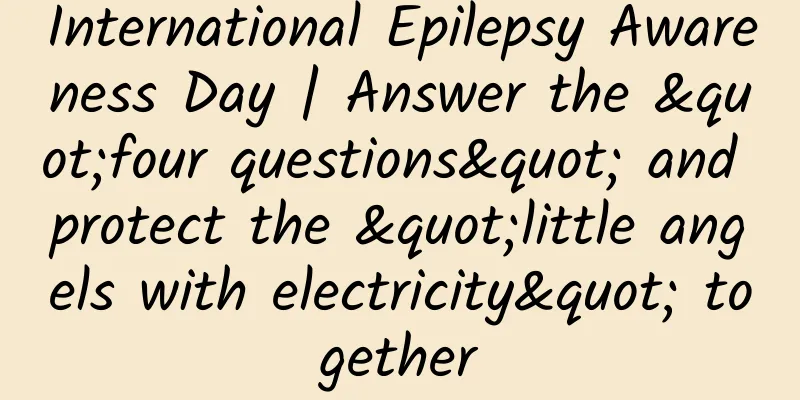International Epilepsy Awareness Day | Answer the "four questions" and protect the "little angels with electricity" together

|
June 28 International Epilepsy Awareness Day Epilepsy is a common disease of the children's nervous system. It is caused by abnormal excessive synchronous discharge of brain neurons due to various reasons, which leads to sudden and paroxysmal brain dysfunction. Due to the imperfect development of children's nervous system and high nerve excitability, the peak period of epilepsy is in infancy. What are the symptoms of childhood epilepsy? Is there a reliable diagnostic method? How should drugs be used safely and reasonably? Yaowa has arranged four questions for you. Use "addition, subtraction, multiplication and division" skillfully to protect the "little angel with electricity" together! Do addition, be good at observation, and answer the "recognition questions" well The clinical manifestations of childhood epilepsy are complex and varied. The most common epileptic seizure in life is a major seizure, that is, the child will have obvious symptoms, such as suddenly fainting on the ground, loss of consciousness, and then the whole body stiffens and convulses, the eyes roll up, and foams at the mouth. Of course, some atypical seizure symptoms may also appear, such as suddenly becoming dazed, drooling, swallowing, sucking, or nodding frequently while playing. These actions only last for a few seconds, and the child wakes up immediately after the attack, so they are often easily overlooked. Epileptic seizures can be large or small, dynamic or static, and we must strengthen observation, pay more attention to these "small movements", and answer the "identification questions" well. Do subtraction, keep the real cause, and answer the "diagnostic question" well There are many types of childhood epilepsy and they vary greatly from person to person. The diversity of symptoms also makes diagnosis more difficult. If the diagnosis is not made early, repeated epileptic seizures can easily cause secondary damage to the child's brain, which may lead to cerebral palsy, intellectual decline, etc. 1. Medical history is the basis Parents should collect information and inform the doctor in detail about the child's current medical history (such as age of first seizure, frequency of seizures, symptoms, state of consciousness, duration), past medical history (whether there is a history of high fever convulsions, brain injury), and family history (whether there is a hereditary condition) to ensure the completeness of the medical history. 2. Video EEG is an auxiliary It can check whether epileptic waves appear (i.e. epileptic discharges), and is the most important auxiliary means for diagnosing epileptic seizures and determining the type of seizure. In addition, neuroimaging examinations can help discover structural abnormalities in the brain and provide etiology diagnosis for epilepsy, which is of great value; genetic testing can provide reference for relevant treatment plans. These methods are very helpful for later treatment. Only by answering the "diagnostic questions" well and reducing missed diagnoses can epilepsy be better controlled. Do multiplication, increase efficacy, and answer the "medication question" well Anti-epileptic seizure drug treatment is the cornerstone of epilepsy treatment and the first choice for epilepsy. There are many types of anti-epileptic seizure drugs, such as traditional sodium valproate, phenytoin sodium, phenobarbital, carbamazepine; new lamotrigine, levetiracetam, topiramate, perampanel, etc. The mechanism of action of these drugs is complex and they have a great influence on each other, so children's choices are limited. Only by answering the "drug use question" well can the best effect of the drug be exerted. 1. Choose the right dosage form It is recommended that oral liquid preparations such as solutions, syrups, and suspensions be used as the first choice for newborns, infants, and preschoolers. As children grow older and their swallowing function improves, they can gradually use tablets and capsules. For children with poor swallowing function and prone to choking and suffocation, liquid preparations are still the main choice. 2. Individualized treatment dose The drug should be used under the guidance of a doctor starting with a small dose and gradually increased until the attack is controlled or the maximum tolerated dose is reached. Do not increase or decrease the dose at your own discretion during the medication process. 3. Monotherapy is preferred, and combination therapy should be used with caution After the first anti-epileptic drug fails, another anti-epileptic drug can be tried. If the second monotherapy also fails, then combination therapy can be considered. Do not blindly increase the number of drugs to avoid drug interactions, affecting drug efficacy, and increasing adverse reactions. Do division, eliminate risks, and answer the "guardianship question" well Controlling epilepsy symptoms is a long-term battle. The treatment cycle of anti-epileptic drugs is long, and adverse drug reactions are inevitable during use, which also affects treatment compliance and leads to failure of epilepsy control. Therefore, during the treatment process, we must pay attention to the efficacy of the drugs in children, monitor the occurrence of adverse drug reactions, and intervene in time to eliminate them. 1. Start with “quantity” Start with a low dose, increase the dose slowly, and monitor blood drug concentrations when necessary. 2. Do a good job of assessment Before taking the medicine, we should pay attention to the child's medical history, especially mental and cardiovascular diseases. During the medication period, we should have regular follow-up visits to evaluate the child's mental state, liver and kidney function, and adjust the dosage of the medicine in time according to clinical symptoms; individual evaluation should be carried out before stopping the medicine. 3. Improve records Take medication on time and in the right amount. If conditions permit, use mobile phones and video recording equipment to accurately record the form and frequency of epileptic seizures, providing a basis for clinicians to formulate and adjust treatment plans. The treatment of childhood epilepsy should be started early rather than late. Be careful in "addition" and pay attention to identification; be precise in "subtraction" and assist in diagnosis; be good at "multiplication" and use medications rationally; and be brave in "division" and provide safe monitoring. |
<<: Can eating rice cause allergies? Do you know these strange allergens?
>>: Medical Science Popularization丨Thyroid nodules, a few things you need to know!
Recommend
How does a pregnant woman lower her copper level?
High copper levels in pregnant women generally ha...
What is the correct way to clean the vulva?
When female friends clean their vulva in daily li...
Can pregnant women drink cold water?
When it comes to drinking water, everyone has dif...
How many months is it best for pregnant women to take calcium tablets
We know that it is very necessary for women to su...
Is Phalaenopsis easy to keep alive? How to care for newly bought Phalaenopsis?
Phalaenopsis is very common in our daily life. It...
Why can laughing make your breasts bigger?
Breast augmentation, also known as breast implant...
Why is there still no movement after 39 weeks?
Generally speaking, a woman is considered full-te...
What is the fastest way to treat low blood pressure in pregnant women?
Nowadays, many people often suffer from three hig...
Causes of an Immature Cervix
The cervix is an important part of the female r...
Is it serious to have 12 follicles in the ovary?
Women's reproductive health issues have alway...
How to treat vulvar atrophic lichen
For friends suffering from vulvar atrophic lichen...
Girls have acne and itching in their genitals
Women's private parts are sensitive and myste...
I got pregnant the same month after the MRI.
Magnetic resonance imaging has not been found to ...
Causes of nighttime abdominal pain during early pregnancy
For female friends who have just become pregnant,...
Will my stomach still hurt after I have a medical abortion and expel the gestational sac?
In the early stages of pregnancy, if the test tub...









